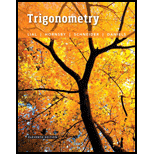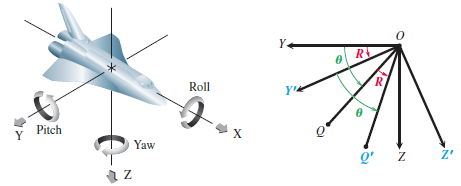
(Modeling) Roll of a Spacecraft The figure on the left below shows the three quantities that determine the motion of a spacecraft. A conventional three-dimensional spacecraft

y = r cos θ and z = r sin θ.
When the spacecraft performs a rotation, it is necessary to find the coordinates in the spacecraft system after the rotation takes place. For example, suppose the spacecraft undergoes roll through angle R. The coordinates (x, y, z) of point Q become (x', y', z'), the coordinates of the corresponding point Q'. In the new reference system, OQ' = r and. because the roll is around the x-axis and angle Y' OQ' = YOQ = θ.
x' = x, y' = r cos(θ + R), and z' = r sin(θ + R).
(Source: Kastner, B., Space Mathematics. NASA.)
Write y' in terms of y, R, and z
Want to see the full answer?
Check out a sample textbook solution
Chapter 5 Solutions
Trigonometry plus MyLab Math with Pearson eText -- Access Card Package (11th Edition)
- ketch a graph of the function f(x) = 3 cos (표) 6. x +1 5 4 3 3 80 9 2+ 1 -9 -8 -7 -6 -5 -4 -3 -2 -1 1 2 3 4 5 6 7 -1 -2 -3+ -4 5 -6+ Clear All Draw: пи > Next Questionarrow_forward3 2 20-10-18-17-16-15-14-13-12-11-10-9 -8 -7 -6 -$4-3-2-1 -1 -2 -3 4- -5+ The curve above is the graph of a sinusoidal function. It goes through the points (-8, -4) and (6,-4). Find a sinusoidal function that matches the given graph. If needed, you can enter π=3.1416... as 'pi' in your answer, otherwise use at least 3 decimal digits. f(x) = > Next Question Barrow_forwardX Grades for X Assignmen X A-Z Datab XE Biocultural X EBSCO-Ful X Review es/119676/assignments/3681238 Review Quiz 8.1-p2 points possible Answered: 3/5 ● Question 1 4+ 3. 2 1 13 /12-11 -10 -9 -8 -7 -6 -5 -4 -3 -2 -1 1 2 3 4 -1 -2 -3 -4- 5 2 6 The curve above is the graph of a sinusoidal function. It goes through the points (-7,0) and (3,0). Find a sinusoidal function that matches the given graph. If needed, you can enter π=3.1416... as 'pi' in your answer, otherwise use at least 3 decimal digits. f(x) = > Next Question 申 J % F 刀 Q Search S € t ח Y 7 I * 00 J ப I Darrow_forward
- 2 d) Draw the following graph on the interval k 5π Next Questionarrow_forwardDraw the following graph on the interval 5л Next Questionarrow_forwardDraw the following graph on the interval πT 5π < x < x≤ 2 2 y = 2 cos(3(x-77)) +3 6+ 5 4- 3 2 1 /2 -π/3 -π/6 Clear All Draw: /6 π/3 π/2 2/3 5/6 x 7/6 4/3 3/2 5/311/6 2 13/67/3 5 Question Help: Video Submit Question Jump to Answerarrow_forward
- The hydraulic cylinder BC exerts on member AB a force P directed along line BC. The force P must have a 560-N component perpendicular to member AB. A M 45° 30° Determine the magnitude of the force P. The magnitude of the force P is N. 8arrow_forwardneed help with my homeworkarrow_forwardTwo planes are flying at the same altitude. One airplane is 60 miles due north of the control tower.Another airplane is located 70 miles from the tower at a heading of 80° east of south. To thenearest tenth of a mile, how far apart are the two airplanes?arrow_forward
- The 50 pound force is to be resolved into components along lines A-A’ and B-B’. 1. Determine the angle α that thecomponent along A-A’ is 35 pounds. 2. What is the value of the component along B-B'arrow_forwardActividades: malemática (Erigonometria) Razones trigonometrica 2025 23 Jures Encuentra las seis razones of trigonométricas, on los siguienter tiringher rectangulies 4 A C =7 b=8cm. * c C=82m a=? * C * B A 4A=- 4 B= C=12cm B 9=7 C A b=6um B a=6cm Sen&c=- AnxB=- Sen&A = Anx = - Bos *A= - cos &c= Zang KA= Tong&c= ctg & A= — ctg &c= Séc & A = - Cosc&A= Secxce csck(= cos & C = - cos & B= Tong & C = — tang & B = d=g&c= cfg &c=— cg & B= sec &C= secxB=- оскв=- =_csCKB = 6=5m AnxA = - AnxB= cos * A= - cos &b= Tmg & A = - Tong & B=- ct₁ A = - C√ B=- cfg & Soc *A= Sec & B=- ACA=- CAC & B=- FORMATarrow_forwardClint is building a wooden swing set for his children. Each supporting end of the swing set is to be an A-frame constructed with two 10 foot long 4-by-4s joined at a 45 degree angle. To prevent the swing set form tipping over, Clint wants to secure the base of each A-frame to concrete footings. How far apart should the footings for each A-frame be?arrow_forward
 Trigonometry (MindTap Course List)TrigonometryISBN:9781337278461Author:Ron LarsonPublisher:Cengage LearningAlgebra & Trigonometry with Analytic GeometryAlgebraISBN:9781133382119Author:SwokowskiPublisher:Cengage
Trigonometry (MindTap Course List)TrigonometryISBN:9781337278461Author:Ron LarsonPublisher:Cengage LearningAlgebra & Trigonometry with Analytic GeometryAlgebraISBN:9781133382119Author:SwokowskiPublisher:Cengage Algebra and Trigonometry (MindTap Course List)AlgebraISBN:9781305071742Author:James Stewart, Lothar Redlin, Saleem WatsonPublisher:Cengage Learning
Algebra and Trigonometry (MindTap Course List)AlgebraISBN:9781305071742Author:James Stewart, Lothar Redlin, Saleem WatsonPublisher:Cengage Learning Holt Mcdougal Larson Pre-algebra: Student Edition...AlgebraISBN:9780547587776Author:HOLT MCDOUGALPublisher:HOLT MCDOUGAL
Holt Mcdougal Larson Pre-algebra: Student Edition...AlgebraISBN:9780547587776Author:HOLT MCDOUGALPublisher:HOLT MCDOUGAL



